If you’re looking for help to identify black birds with long beaks, this will be the best article you read today.
In this post, you will find photos, identification info, beak lengths, calls, and all the fun facts you need.
Examples of black birds with long beaks include the toco toucan, African openbill, black eagle, black stork, rhinoceros hornbill, great cormorant, American crow, and many others.
Long beaks in birds are an evolutionary adaptation that helps in multiple situations:
- They allow birds to firmly grab their prey/food and prevent it from escaping
- Some birds use their beaks to thermoregulate their body temperature
- Beaks can also play a part in selecting mates as males with longer beaks have a bigger chance of attracting mates
- Long beaks can be also useful when probing the ground or skimming water surface in pursuit of the next meal
- They can also play a part in scaring away predators and defending territory
Here are 25 of the most interesting ones.
Table of Contents
Black Birds With Long Beaks
African Openbill
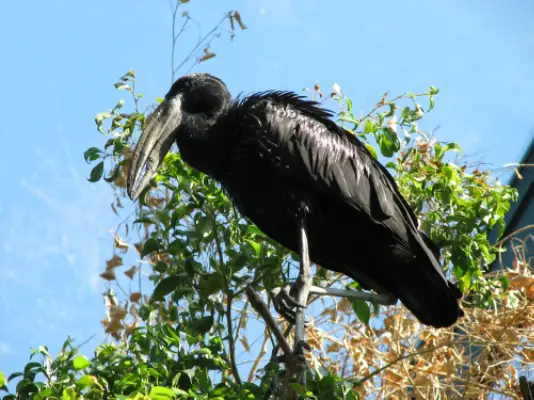
- Scientific Name: Anastomus lamelligerus
- Lifespan: up to 7 years
- Body Length: 31.5-37 in
- Beak Length: 5.3-7.7 in
African openbills are medium-sized storks found in sub-Saharan Africa and Madagascar.
They inhabit freshwater wetlands, including marshes, swamps, margins of lakes and rivers, ricefields, and flooded plains.
Females resemble males but the males are slightly larger and have longer and heavier beaks.
African openbills have black plumage with some glossy green, brown, or purple feathers and very long beaks.
Their beaks are brown, measure 5.3-7.7 inches in length, and have a wide gap (0.6 in) between the mandibles.
There are two subspecies, one found in Africa and the other in Madagascar – Madagascar openbills are smaller and have thinner beaks with more pronounced ridges.
Identify these black birds with long beaks also by their loud croaks and honks and bill clatters during displays.
African openbills are carnivores and have a diet consisting of aquatic snails, mussels, some frogs, crabs, insects, and fish.
Their beaks evolved with their diet – the upper mandible is almost straight and has around 20-30 small columnar pads to better grip the shell and extract the mollusks.
African openbills are very social and nest in colonies. They breed from August to May, build small nests using sticks, grass, leaves, and reeds, and have a clutch of 3-4 white eggs that both parents incubate.
Toco Toucan
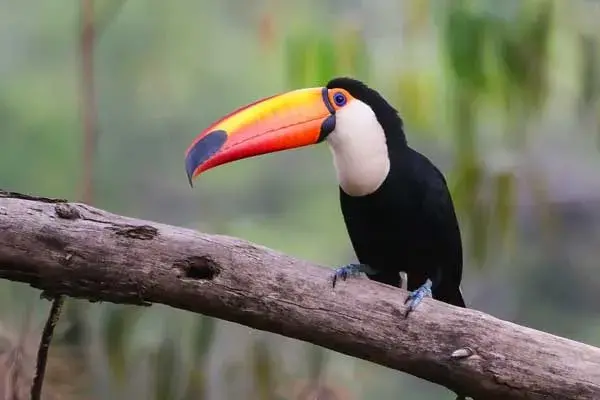
- Scientific Name: Ramphastos toco
- Lifespan: 20 years
- Body Length: 22-26 in
- Beak Length: 6.2-9 in
Toco toucans are the largest and most famous members of the toucan family.
They are also known as giant toucans and common toucans and have black plumage with white throats and orange skin around their eyes.
Toco toucans’ most prominent feature is the beak which is 6.2-9 inches long and has a bright orange color.
Compared to their body size, they have one of the largest beaks in the world that take 30-50% of their total body surface area!
Although it seems massively heavy, the beak is very light because it is hollow and made of keratin (a protein our hair, skin, and nails are made of).
When they sleep, toucans tuck their beaks under their feathers to keep them warm.
On the other hand, when the weather gets very hot, 30 to 60% of heat is lost through the beak.
Charles Darwin described toucan beaks as: “toucans may owe the enormous size of their beaks to sexual selection, for the sake of displaying the diversified and vivid stripes of color with which these organs are ornamented“.
Their huge beaks also help scare away other birds trying to rob their nests, they play a part in the social selection, and serve as a visual warning.
Toco toucans are not very good fliers and mainly travel among trees by hopping.
They inhabit the semi-open habitats of central and eastern South America, countries like Bolivia, Peru, Argentina, Paraguay, and Brazil.
Toco toucans are omnivores that also use their massive orange beaks to pluck fruit from trees and grab some insects, frogs, small birds, their eggs, and even small reptiles.
Here’s also what these birds would look like without beaks.
Rosy-Billed Pochard
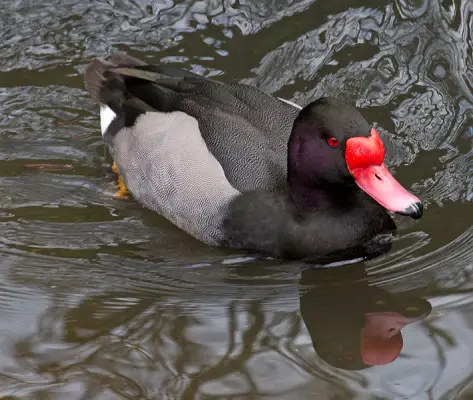
- Scientific Name: Netta peposaca
- Lifespan: 5-10 years in the wild
- Body Length: 22 in
- Beak Length: n/a
These unmistakable diving ducks endemic to South America are also known as rosybills.
Rosy-billed pochards inhabit marshes, shallow waters, duckweed-covered ponds, swamps, and small lakes with floating vegetation of Uruguay, Paraguay, Chile, Brazil, and Argentina.
Their scientific name “Netta” is an ancient Greek word meaning “duck” while the “peposaca” comes from the South American Guarani language meaning “snowy wings” and refers to their white wing stripes best seen during flight.
Males have striking black plumage, white vents, gray sides, and bright red eyes.
Rosy-billed pochards also have long bright rosy red beaks with bulbous basal shields that increase in color and size when the breeding season comes.
Females have brown plumage, dark beaks, white bellies, and yellow-orange or gray legs.
Identify rosy-billed pochards also by their deep honks.
These ducks are partially migratory and move to lower altitudes when the winter comes.
They are very gregarious and might form flocks that can include thousands of birds outside the breeding season.
Rosy-billed pochards will stay together only for a season; they breed from October to November and females build nests using leaves, grass, and twigs on water shores with vegetation as cover.
They lay up to 10 cream-greenish colored eggs, occasionally in other birds’ nests, and raise the ducklings without males helping them.
Rosy-billed pochards are omnivores and feed on grass, seeds, aquatic plants, and some animal products.
Despite being classified as diving ducks, they rarely dive and primarily forage by dabbling on the water surface.
Read More: Examples of ducks with orange beaks
Red-billed Chough
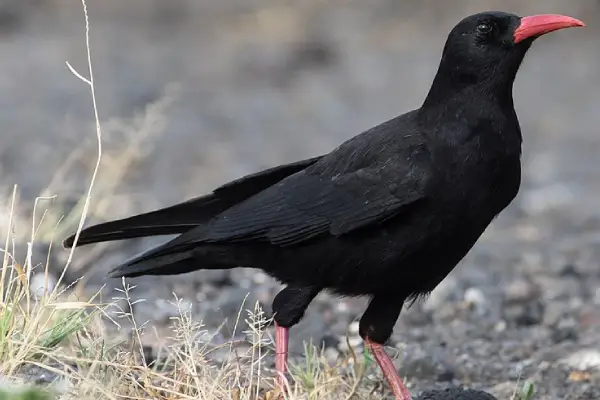
- Scientific Name: Pyrrhocorax pyrrhocorax
- Lifespan: about 7 years
- Body Length: 15-16 in
- Beak Length: 0.54-0.57 in
Red-billed chough is a large black bird with a long, slender, and curved red bill. The bill measures 0.54 inches on average in females and 0.57 inches in males.
According to Allen’s rule stating that animals living in colder climates have shorter limbs and bodily appendages compared to animals living in warm climates, red-billed choughs from warmer areas have longer bills.
They are found in Europe, Asia, and Africa, and inhabit coastal sea cliffs and high mountains; at elevations ranging from 6,600 to 8,200 ft in Africa and from 7,900 to 9,800 ft in Asia.
Red-billed choughs are very vocal species and have several vocalizations: the flight “kwee-ow” call and “ker-ker” alarm call. Pairs will also make soft warbling when together.
Source: See page for author, CC BY 4.0, via Wikimedia Commons
Red-billed choughs are social and can be often seen in pairs, small flocks, or huge groups with hundreds of individuals.
When the breeding season comes, they become territorial and will try to scare away predators with their spectacular areal displays.
These choughs nest in rocky crevices, cliff ledges, or mountain caves; they use twigs, roots, and mud as a building material and lay 3-5 pale buff, creamy, or green eggs with brown marks. Both partners build the nests and males often feed females as they incubate the eggs.
Red-billed choughs are omnivores and feed on insects, spiders, worms, seeds, and berries.
Black Eagle

- Scientific Name: Ictinaetus malaiensis
- Lifespan: n/a
- Body Length: 30 in
- Beak Length: n/a
Black eagles are large but slender birds of prey found in forested mountains and hills of southern and southeastern Asia.
They measure 30 inches long, weigh 2.2-3.5 pounds, and span up to 6 feet across the wings.
Adult black eagles are all-black and have massive yellow bills with silver tips.
They also have broad wings with distinct “fingers” (emarginated primary feathers) and long tails that are fan-shaped when open and wedge-shaped when closed.
Black eagles breed in tropical and subtropical Asia, in countries like Nepal, India, Burma, China, and Taiwan.
Females will lay 1-2 white eggs with brown spots.
Black eagles are carnivores and feed on mammals, birds, and eggs. They hunt by soaring over creeks, rivers, and forests, and will fly at lower speeds to spot their prey, hence their long primaries.
Black Stork

- Scientific Name: Ciconia nigra
- Lifespan: up to 36 years in captivity
- Body Length: 37-39 in
- Beak Length: 7 in
Black storks are large black birds with sturdy builds and reddish legs.
They have a wingspan of over 5 feet, measure 37-39 inches in length, and can weigh up to 6.6 pounds.
Identify adult black storks by their mostly black plumage, white underparts, and their long pointed red bills that measure around 7 inches in length.
Males are slightly larger than females.
Black storks are commonly found around woodlands and wetlands of Europe, Asia, and Africa.
A rather shy and cautious species that tend to avoid humans, black storks can be mostly found alone or in pairs.
They nest in large forest trees, large boulders, or under overhanging ledges in mountainous areas.
Black storks are carnivores that feed on fish, insects, and amphibians. They can be often seen wading slowly in shallow waters, stalking their prey.
These huge wading birds fly with their necks outstretched.
Black storks have several vocalizations, including the most common “chee-lee” call, hissing call, and different squealing calls.
Source: Jamescandless, CC BY-SA 3.0, via Wikimedia Commons
Black storks are seasonally monogamous, they stay with their partner during the breeding season. Both parties will build the nest and take care of the young.
Great Hornbill
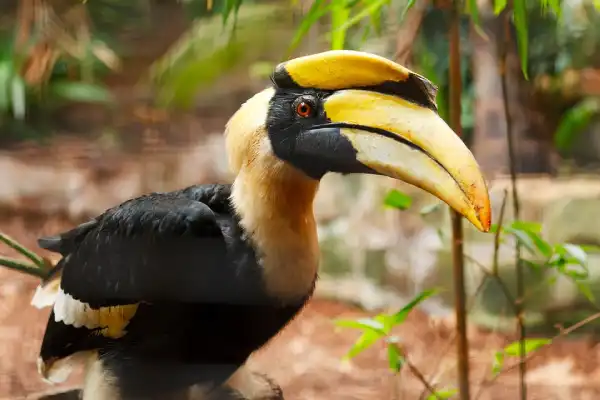
- Scientific Name: Buceros bicornis
- Lifespan: 35-40 years
- Body Length: 37-51 in
- Beak Length: n/a
Great hornbills are one of the biggest hornbill species.
They measure 37-51 inches in length, weigh 4.4-8.8 pounds, and span 59-70 inches across the wings.
They are known under many names, including concave-casqued hornbills, great Indian hornbills, and great pied hornbills.
Their scientific name “bicornis” comes from a Latin word meaning “two-horned” which perfectly describes these birds.
Great hornbills’ most prominent features are their long bright yellow bills and casques on top of their massive bills.
To support such long beaks, these hornbills have their first two neck vertebrae fused; although the beaks seem quite heavy, they are actually very light as they are hollow and made up of thin-walled hollow cells.
When viewed from the side, the casques have a U-shape. Although the main function is unknown, scientists think that such bills play part in partner selection.
Identify great hornbills also by their black bodies, heads, and wings, and white necks, abdomens, and tails.
Great hornbills are commonly found in wet evergreen and deciduous old-growth forests of southeastern Asia, in countries like Bhutan, Nepal, Cambodia, Laos, Vietnam, and Thailand.
They are omnivores and most (70%) of their diet includes fruits, especially figs; they will also feed on small mammals, birds, eggs, reptiles, and insects.
Great hornbills are monogamous and to win a female, males will often fight by butting their casques.
Females lay 2 eggs and males feed them as they incubate their future offspring.
Great hornbills are very vocal species – pairs will often sing in a duet as part of their courtship behavior; these birds will also make loud calls in their communal roosts.
Source: Shino jacob koottanad, CC BY-SA 4.0, via Wikimedia Commons
They are the state birds of Kerala, a state in India.
Fun Fact: Great hornbills do not need to drink – they obtain all the water they need from their diet!
Yellow-throated Toucan
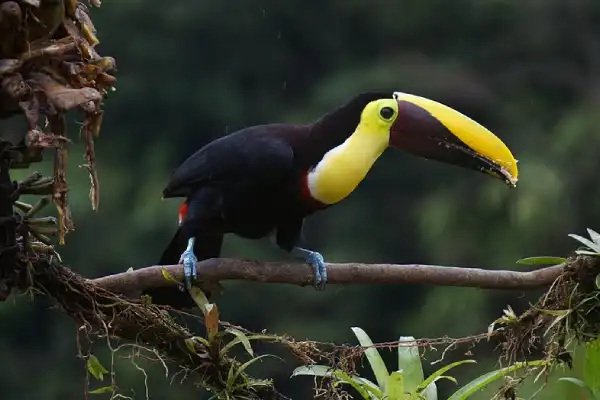
- Scientific Name: Ramphastos ambiguus
- Lifespan: n/a
- Body Length: 18.5-24 in
- Beak Length: 5.1-7.9
These large toucans are native to Central and South America.
Yellow-throated toucans inhabit different areas, ranging from plains to tropical and subtropical forests of Peru, Ecuador, Colombia, and Venezuela.
Yellow-throated toucans are mostly black and have huge bills that measure from 5 to 8 inches in length – the beaks take over 30% of their total body length.
Their bicolor bills are lemon yellow above and dark below; males have slightly longer bills than females.
As the name suggests, these toucans also have bright yellow throats and faces.
Identify them by their yelping call that people describe as “Dios-te-de” meaning “God give you”.
They breed from March to June, build their nests in tree cavities above the ground, and lay 2-4 white eggs.
Yellow-throated toucans are omnivores and primarily feed on fruits, occasionally on some rodents, insects, lizards, and smaller birds.
Red-naped Ibis
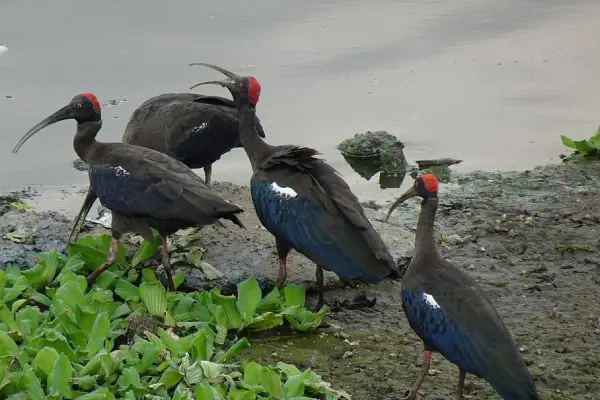
- Scientific Name: Pseudibis papillosa
- Lifespan: up to 30 years
- Body Length: 23.6-26.8 in
- Beak Length: 5.5 in
Red-naped ibises are medium-sized ibises commonly found in the plains of southern Asia, mostly in India.
They mostly inhabit lakes, marshes, riverbeds, and irrigated farmlands.
Due to their range and color, people also refer to them as Indian black ibises or simply black ibises.
Red-naped ibises are large black birds with long downcurved beaks that are around 5.5 inches long.
The upper mandible is longer than the lower mandible; there is also a gap between the two.
Their bills are gray but turn reddish when the breeding season comes.
Red-naped ibises have all-black plumage with crimson red patched on their crowns and napes, white skin patches on their shoulders, and black wings with blue-green gloss.
Although mostly quiet, these red and black birds will make various squealing and screaming calls.
Red-naped ibises can be commonly spotted alone or in loose groups.
They breed from March to October and use different sticks, straws, and fresh grasses to build their nests. Females will lay 2-4 pale bluish eggs and both parents will incubate them.
Red-naped ibises are omnivores and have a diet consisting of insects, frogs, grain, and even carrion.
They forage by probing on the ground and the beaks and corresponding epidermal structures are adapted to such a way of feeding.
Their stout, rigid, thick, and extremely elongated beaks help scratch the soil without injury and handle the hard seeds more easily- the gap between the mandibles ensures these birds have a strong grip over their prey.
Yellow-rumped Cacique

- Scientific Name: Cacicus cela
- Lifespan: n/a
- Body Length: 9-11 in
- Beak Length: n/a
Yellow-rumped caciques are long and slim perching birds found in northern parts of South America.
They inhabit open woodlands, mangrove forests, and cultivated areas with open fields from Panama and Trinidad to Brazil and Peru.
Yellow-rumped caciques have black plumage with bright yellow wing patches, rumps, and undertails, and long and pale yellow pointed beaks.
The color of their beaks can be used to determine age: one-year-old caciques have brown patches on the base of their beaks while the two-year-old ones have clear yellow bills.
Recognize them also by their blue eyes and a song that consists of fluting notes with cackles and wheezes; occasionally they might mimic the calls of other birds.
Source: Niels Krabbe, CC BY-SA 4.0, via Wikimedia Commons
These blackbirds with yellow wings are omnivores and have a diet consisting of insects, spiders, nectar, and fruit.
As part of their courting ritual, males will flap their wings and display their yellow wing feathers.
Females build pouch-shaped nests in tall trees with an active wasp nest around to keep predators away; they will lay 1-3 bluish-white eggs. They nest colonially, with up to 100 nests built in a single tree.
Great Frigatebird
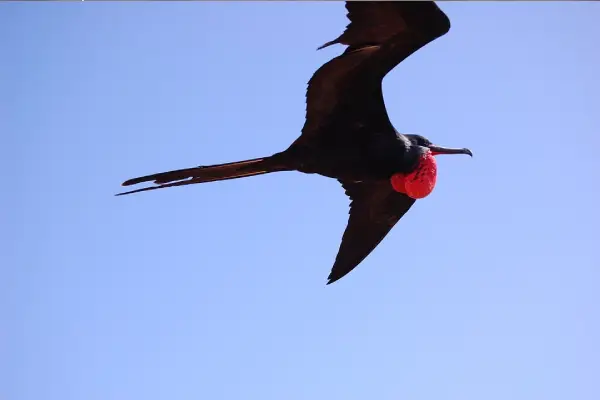
- Scientific Name: Fregata minor
- Lifespan: up to 40 years
- Body Length: 33-41 in
- Beak Length: 3.6-4.4 in
Great frigatebirds are large seabirds found in the tropical Pacific and Indian Oceans and the South Atlantic Ocean.
They can grow up to 3.4 ft long, span 7 ft 7 in across the wings, and weigh as much as 3.5 lbs.
Males are completely black and have striking red gular sacs they inflate to attract females; females have white throats.
Great frigatebirds also have long and narrow gray bills with the upper mandible ending in a hook; females have longer beaks than males.
As part of the courtship ritual, great frigatebirds will also clatter their beaks, wave heads and wings, and males will call to females while flying overhead.
These birds have the highest ratio of wing area to body mass and the lowest wing loading of any bird – scientists speculate that this helps them soar at great heights and preserve energy.
Great frigatebirds are seasonally monogamous and stay together for a season.
Just like magnificent frigatebirds, these black water birds will steal fish and other food from other seabirds.
They will chase and harass birds, make them regurgitate their food, and then swoop in and catch the food in the air.
Magnificent Frigatebird

- Scientific Name: Fregata magnificens
- Lifespan: 14-30 years
- Body Length: 35-45 in
- Beak Length: 4.2-4.9 in
These enormous seabirds are found around coasts and islands in tropical and subtropical waters.
Magnificent frigatebirds can measure almost 4 feet long, weigh 2.4-3.5 pounds, and span up to 8 feet across the wings; this makes them the largest species of frigatebird in the world.
In North America, they are most commonly found in the Gulf of Mexico, around states like Texas and Florida.
Named magnificent due to their striking appearance and behavior, these large red and black birds are easy to recognize due to their huge size, long pointed wings, and long and deeply forked tails.
Males are all-black and have scarlet throat pouches they inflate like balloons during the breeding season; females are also black but have white breasts and lower neck sides.
Magnificent frigatebirds have very long and hook-tipped beaks that are an adaptation to snatching prey from the water surface; they might also use their hooked beaks to pin food between both jaws until they can flip around and swallow it.
They mostly feed on fish taken in flight from the ocean’s surface and their favorite food is flying fish, tuna, and squid.
Magnificent frigatebirds are kleptoparasitic – this means that they harass and steal fish from other animals.
Despite their massive wingspans, these birds can’t land on water as their feathers aren’t waterproof and they would most likely drown.
Fish Crow

- Scientific Name: Corvus ossifragus
- Lifespan: up to 14 years
- Body Length: 14.2-15.8 in
- Beak Length: 1.8 in
Fish crows are small crow species found in the eastern and southeastern United States.
These birds that are endemic to Florida look like smaller versions of the American crows.
Fish crows have sturdy legs, dark brown eyes, and broad wings; their plumage is all-black and their heavy bills measure around 1.8 inches long.
They are found around coastal marshes and beaches, rivers, inland lakes, river banks, and urban areas.
Listen for their nasal “ark-ark-ark” and mechanical rattle calls.
They have a particular habit of robbing nests – fish crows will raid the nests of many kinds of waterbirds and songbirds or dig up turtle eggs.
Fish crows are omnivores that feed on fish, crabs, shrimps, fruits, grains, peanuts, and even human scrap.
They often forage on the ground or in shallow waters where they can be seen plucking food out of the water with their feet.
American Crow
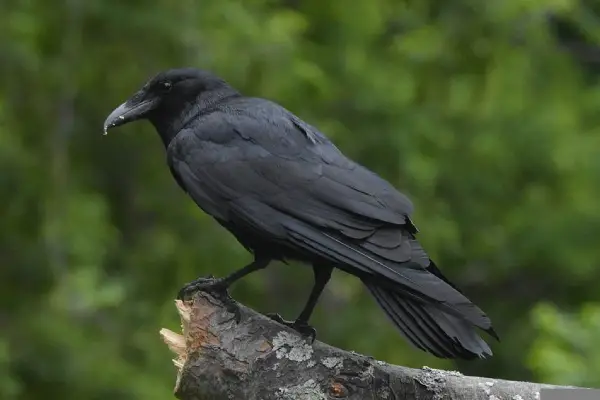
- Scientific Name: Corvus brachyrhynchos
- Lifespan: 7-8 years in the wild
- Body Length: 16-20 in
- Beak Length: 1.2-2.2 in
American crows are large and aggressive black birds found throughout most of North America.
Despite having very harsh-sounding calls, they are considered songbirds.
American crows can be recognized by their all-black plumage and large bills.
Despite having a scientific name that means “short-billed”, these crows have rather large bills that can measure from 1.2 to 2.2 inches, depending on the location.
They can be often found around woods and urban areas and recognized by their loud, short, and rapid “caaw-caaw” calls.
Source: G McGrane, Public domain, via Wikimedia Commons
Often associated with trickery and death, American crows are large and intelligent birds with an IQ similar to that of chimpanzees.
These birds are omnivores and feed on earthworms, insects, other small animals, seeds, fruit, even garbage, and carrion.
Fun Fact: American crows can be often seen holding “funerals” – when one crow discovers a dead one, it will call others. Groups of crows will gather, spend 10 to 15 minutes around the cadaver, and disperse and fly off silently.
Anhinga

- Scientific Name: Anhinga anhinga
- Lifespan: 12 years
- Body Length: 30-37 in
- Beak Length: 3.2 in
Anhingas are large and glossy black water birds commonly found around lakes, freshwater marshes, ponds, and canals of southern USA, Mexico, Central, and South America.
They are also known as snakebirds, darters, or water turkeys.
When they swim, only their long necks and beaks appear above water, making them look like snakes, hence the nickname snakebird.
Male anhingas have black plumage with white spots on their wings and backs while the females look similar but have brownish necks and heads.
Anhingas have long yellow beaks that are sharply pointed, almost like daggers. The beaks are around 3.2 inches long and are used for hunting and spearing fish.
These long-billed black birds can be also identified by their loud clicking calls that resemble sewing machines or croaking frogs.
Source: National Park Service, Public domain, via Wikimedia Commons
Anhingas do not have waterproof wings as other birds do and can be often seen drying their feathers in the sun.
They are carnivores that feed on fish, insects, shrimp, crayfish, and sometimes even young alligators and snakes.
Black Oystercatcher

- Scientific Name: Haematopus bachmani
- Lifespan: 10-14 years
- Body Length: 15-19 in
- Beak Length: 2.9-3.5 in
These conspicuous shorebirds are common on the shorelines of western North America.
Black oystercatchers inhabit rocky marine habitats that provide both nesting and foraging areas.
Adults are all-black with long orange-red beaks that measure from 2.9-3.5 inches long.
Identify them also by their pink legs, red eyes, and orange-red rings around them.
The thick and long beaks have a strong orange-red glow to them and from distance, it looks like these birds are eating a carrot!
Black oystercatchers’ beaks are razor-sharp which is very useful for prying open oysters and other bivalves for food.
These social birds can be often seen during the day foraging, preening, resting, and sunbathing.
They have a global population of around 10,000 individuals; around 400 of those are estimated to live in the state of Washington.
Part of their scientific name, “Bachmani,” is after John Bachman, the friend of naturalist John James Audubon that named the species.
Northern Bald Ibis

- Scientific Name: Geronticus eremita
- Lifespan: 10-15 years in the wild
- Body Length: 28-31 in
- Beak Length: 4.8-5.5 in
Northern bald ibises, also known as hermit ibises and waldrapps, are long-billed wading birds found in the Middle East and northern Africa.
They breed on cliff ledges in semidesert regions and forage in open dry habitats such as semi-arid steppes and fallow fields.
Part of their scientific name “Geronticus” comes from an old Greek word meaning “old man” and refers to the bald heads older birds have.
Northern bald ibises are large and glossy black birds with very long curved beaks.
Populations of Northern bald ibises living in Morocco have slightly longer beaks than those living in Turkey (5.5 inches compared to 5 inches).
According to a 2007 study, males that have longer bills have better chances of attracting females.
Males are larger and have longer beaks than females.
Despite once being widespread in Europe, Asia, and Africa, northern bald ibises are now listed as Endangered by the International Union for Conservation of Nature (IUCN) with less than 1,000 living in the wild today.
They are mostly silent but will make guttural “hrump” and high-pitched “hyoh” calls during the breeding season.
These large black birds with long beaks mate for life, breed in colonies, and have a clutch of 2-4 whitish eggs with brown spots. Both parents will incubate the eggs and feed the chicks.
During the non-breeding season, northern bald ibises can be seen in groups of up to 100 birds.
They are omnivores and eat different foods, including insects, snails, worms, frogs, and fish. They will use their long beaks to probe the ground in search of food.
Fun Fact: Northern bald ibises have rather long lives in captivity – the oldest recorded male was 37 years old!
Black Skimmer
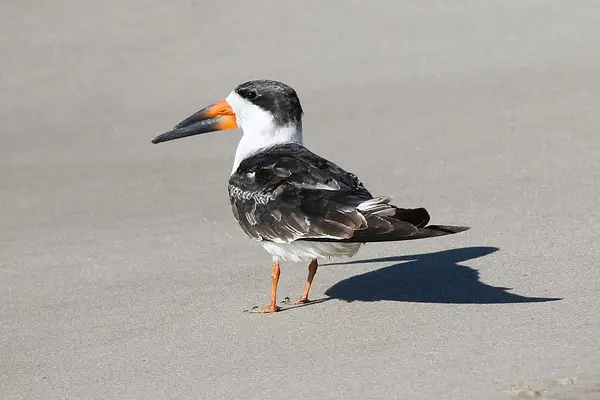
- Scientific Name: Rynchops niger
- Lifespan: up to 20 years
- Body Length: 16-20 in
- Beak Length: 2-2.5 in
Black skimmers are large tern-like seabirds that are black above, white below, and have dark brown eyes, and red legs.
During the non-breeding season, they become browner.
They are the largest of the three skimmer species and can measure up to 1 ft 8 inches in length.
Part of their scientific name, “Rynchops,” comes from the old Greek and means “cut-off bill” which perfectly describes these birds.
Black skimmers have unique beaks where the lower mandible is longer than the upper; this allows them to skim along the water surface and catch fish.
These black water birds have beaks measuring from 2 to 2.5 inches and can be seen around rivers, coasts, and lagoons where they feed on small fish, insects, crustaceans, and mollusks.
Black skimmers are permanent residents of southern parts of the United States, around Alabama, Florida, Louisiana, Mississippi, and Texas.
Identify them by their barking “kak-kak” calls.
They are social birds that nest in colonies with up to several hundred pairs; both parents will take turns and incubate their 3-5 white eggs with brown markings.
Pelagic Cormorant

- Scientific Name: Urile pelagicus
- Lifespan: up to 18 years
- Body Length: 25-35 in
- Beak Length: n/a
Pelagic cormorants are small species of cormorants found along the coasts of the northern Pacific.
They are rather large for seabirds and are also known as Baird’s cormorants and violet-green cormorants.
These birds with long necks and tails are all-black with a metallic iridescence during the non-breeding season. When the breeding season comes, they will develop two short crests on their heads and napes.
Pelagic cormorants also have long thin beaks and large black webbed feet.
Males and females look similar, though males tend to be a bit bigger.
When feeling threatened, they will dart their dark glossy beaks at the intruder, shake their heads, and make a gargling noise.
In North America, pelagic cormorants breed from California all the way to the Aleutian Islands and the west coast of Alaska.
They inhabit coastal shorelines and islands; during winter they might venture into the open ocean.
They can dive up to 140 feet underwater to catch prey and stay there for two minutes.
Pelagic cormorants are carnivores that feed on fish and small crustaceans (shrimp, in particular).
Read More: Examples of birds that share similarities with cormorants
Great Cormorant
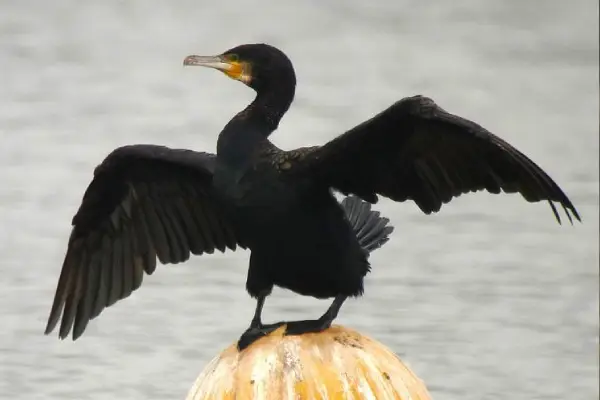
- Scientific Name: Phalacrocorax carbo
- Lifespan: up to 22 years
- Body Length: 27.5-40 in
- Beak Length: 2-3 in
Great cormorants are large and heavy water birds that can weigh over 11 pounds and span over 5 feet across the wings!
They are among the largest species of cormorants and can be identified by their black plumage, short legs, and fairly long tails.
Great cormorants have large, strong bills with a sharp hook at their end; the beaks measure from 2 to 3 inches long and have yellowish skin at the base.
Males are usually bigger than females and have long thick necks and blocky heads.
These largest North American cormorants can be seen along the Atlantic Coast during the non-breeding season.
They are also known as great black cormorants and are excellent swimmers.
They are carnivores and primarily feed on fish, and some crustaceans, amphibians, and insects.
Great cormorants forage by diving, pursue their prey with their feet, and will use their long beaks to capture the prey. They can stay almost half a minute underwater and go as deep as 19 feet!
Although mostly quiet, they will make different guttural noises when the breeding season comes.
Rhinoceros Hornbill
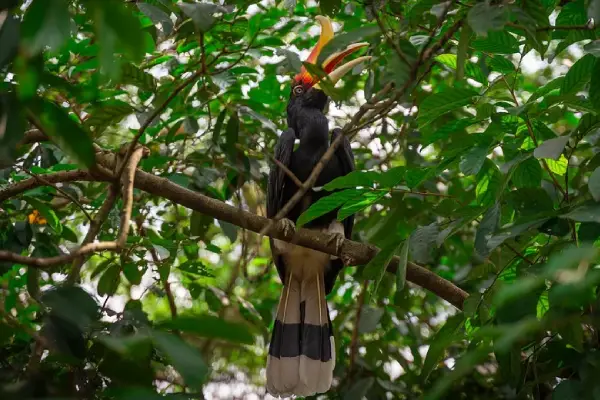
- Scientific Name: Buceros rhinoceros
- Lifespan: up to 35 years in captivity
- Body Length: 31-35 in
- Beak Length: n/a
Rhinoceros hornbills are enormous black birds found in the rainforests of Asia, in Thailand, Singapore, Java, Sumatra, and Borneo.
They can grow almost 3 feet long and weigh as much as 6.4 pounds.
Rhinoceros hornbills have mostly black plumage, white legs, red eyes, and white tails.
These black birds are hard to miss due to their huge orange-red beaks and casques. Those casques are made of keratin and are used to amplify the birds’ calls.
Source: soundbytez, CC BY 3.0, via Wikimedia Commons
Such enormous beaks are actually lightweight and versatile and can be also used to perform different jobs, including food gathering, nest building, and feeding the chicks.
Rhinoceros hornbills are omnivores and feed on fruit, some insect, small reptiles, rodents, and even some smaller birds.
Native Dayak people of Borneo consider rhinoceros hornbills as the chiefs of birds or the supreme worldly birds; they are also state birds of the Malaysian state of Sarawak.
Rhinoceros hornbills are monogamous and usually pair for life.
Common Raven

- Scientific Name: Corvus corax
- Lifespan: 10-15 years in the wild
- Body Length: 21-26 in
- Beak Length: 2.2-3.3 in
Common ravens are massive black birds that can weigh up to 4.4 pounds and span 4 feet 3 inches across the wings.
They are one of the biggest and heaviest songbirds and are commonly found in open and forest habitats across the US.
Identify common ravens by their large size, long tails, and dark brown eyes.
They have iridescent black plumage and big and curved beaks, with a culmen length ranging from 2.2 to 3.3 inches – this makes their beaks one of the longest among perching birds (passerines).
Common ravens look like crows but are much bigger and can weigh more than four times.
These highly intelligent animals have one of the largest brains of all birds; they display great ability in problem-solving, using tools, planning for the future, and even playing games like hide-and-seek.
They are omnivores that feed on almost anything; ravens will consume carrion, insects, cereal grains, berries, fruit, small animals, nesting birds, and food waste.
Fun Fact: Common ravens will resort to “trickery” when hiding food – they will pretend to put the food in one place while actually placing it in another.
Southern Ground Hornbill

- Scientific Name: Bucorvus leadbeateri
- Lifespan: 40-50 years
- Body Length: 35.4-50.8 in
- Beak Length: 6.5-8.6 in
Southern ground hornbills are the largest hornbill species in the world.
These black birds can be identified by the distinctively large, down-curved beaks they use to catch small animals found in the grasses and shrubs.
Southern ground hornbills have beaks measuring from 6.5 to 8.6 inches in length.
Adult males have completely black plumage with vivid red patches of bare skin on their faces and throats; females have bluish throats.
They are commonly found in Southern Africa and inhabit both woodlands and savannas.
As the name suggests, southern ground hornbills will stay most of their time on the ground.
They can fly but some studies discovered that they spend around 70% of their day walking.
Southern ground hornbills are apex predators that hunt reptiles, frogs, snails, insects, and hare-sized mammals.
In the early morning, the song of these red-necked birds can be heard from miles away, with pairs singing in a duet with a deep-bass booming “oooh-oooh-ooh-oh” sounds.
Southern ground hornbills are long-lived species that can live up to 70 years in captivity!
Read More: More examples of incredible birds with red necks
Black Swan
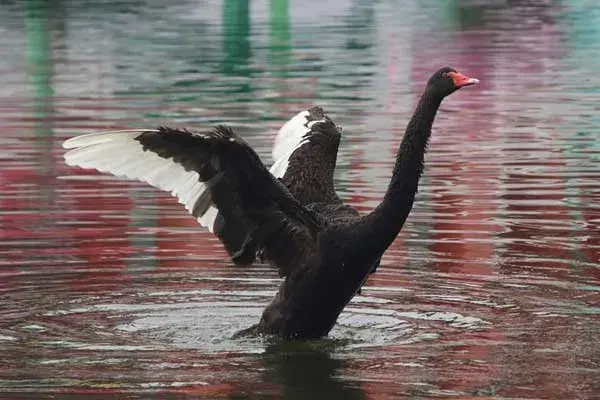
- Scientific Name: Cygnus atratus
- Lifespan: up to 40 years
- Body Length: 43-59 in
- Beak Length: 2.4-2.6 in (juveniles)
Black swans are large water birds native to Australia.
They are common around lakes, swamps, rivers, wetlands, flooded pastures, tidal mudflats, and even the open sea.
They breed in southeast and southwest parts of the continent and have been also introduced to England, New Zealand, the USA, Japan, and China.
Identify black swans by their black color (the only black-colored swan species in the world), white wings with extensive bright flight feathers when flying, and long red beaks.
Males, also known as cobs, are bigger than (pens) females and have longer and straighter bills.
Cygnets (young swans) have beaks that measure around 0.87 inches long; juveniles have beak lengths of 2.4-2.6 inches.
Swans have far more neck bones than mammals – 24 or 25 vertebrae compared to only 7 of most mammals.
As a comparison, giraffes, the animals with the longest necks in the world, have fewer bones in their necks (7 in total) than black swans.
While breeding and nesting, black swans are known for crooning, making a soft singing and humming sound.
They are monogamous, stay together for life, and according to a 2004 study, some pairs might split up (their divorce rate is only 6%).
They will also use only one leg while swimming, tucking the other above their tails.
Black swans are herbivores and feed on algae and weeds.
Inca Tern

- Scientific Name: Larosterna inca
- Lifespan: 2-3 years
- Body Length: 16 in
- Beak Length: n/a
These large terns measure around 16 inches in length.
Inca terns are black-gray seabirds with white mustaches on their faces, white edges on their wings, and long bright orange beaks and legs.
The mustache is the health sign of the tern – the longer it is, the healthier the bird.
They were named so because they are common in the area ruled by the ancient Inca Empire in South America.
They breed on the coasts of Chile and Peru, on rocky cliffs, and can be identified by their catlike “mew” calls.
Inca terns are piscivores that feed on fish, plankton, shrimp, crayfish, crab, etc.
These black water birds are also kleptoparasitic –they steal food from other animals like sea lions and dolphins.
Inca terns will often fly over the water, spot their prey under the surface, and dive into the water and grab it with their sharp, pointed beaks.
Summary
This concludes our list of black birds with long beaks.
Examples of long-beaked black birds include several types of hornbills, skimmers, frigatebirds, storks, toucans, eagles, and many others.
The next time you see any of these birds, you should be able to recognize them with ease!
And if you enjoyed our article, here are our other popular reads on birds: Examples of black birds with orange beaks and Examples of black birds with long tails